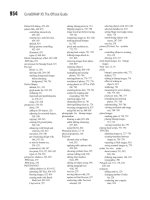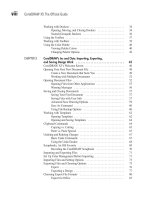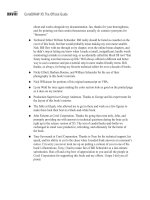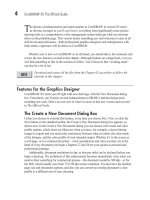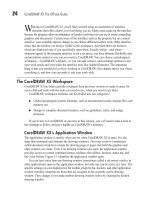CorelDRAW X5 The Official Guide part 20 docx
Bạn đang xem bản rút gọn của tài liệu. Xem và tải ngay bản đầy đủ của tài liệu tại đây (525.88 KB, 10 trang )
●
Tri-Fold Brochure Set your page orientation to Landscape using File | Print
Setup, and you then have the ideal layout for travel brochures and restaurant tabletop
stand-up menus. If your printer supports it, you can print both sides for a total of six
panels, with live space measuring about 3 ½" wide and 8" high on the end panels.
Ill 6-10
After you choose a layout style and return to your document, each subdivision of the
layout can be viewed individually. You can also view pages in pairs by choosing the Facing
Pages option in the Layout page of the Options dialog for several layout styles. When
Facing Pages is selected in the dialog, you also have the opportunity to start your document
on either the Left Side or Right Side for some layout styles by making a selection from the
Start On menu.
Using Preformatted Labels
CorelDRAW has a comprehensive collection of label formats for preformatted paper stock
from vendors such as Avery, Ace, and Leitz. Once you’ve clicked the Labels radio button,
the Page Size page turns into the Label page, offering access to the label collection. After
you’ve selected a specific label format, the preview window shows its general layout and
indicates the number of rows and columns available, as shown in Figure 6-4.
After you choose a label format and return to your document, each of your document
pages will represent an individual label. You’ll need to add the exact number of pages to
accommodate all of your labels. If you don’t see the exact manufacturer for your specific
154 CorelDRAW X5 The Official Guide
label type, you can create your own from scratch, or base it on an existing label format (see
Figure 6-5). Choose an existing label from the Label Types menu; click Customize Label;
set the number of Rows and Columns; and set the Label Size, Margins, and Gutters
according to your own label sheet. Once the format is created, you may save your label by
clicking the plus (+) button next to the Label Style drop-down list. You can delete a selected
label format from the list by clicking the minus (–) button.
CHAPTER 6: Working with Single- and Multi-Page Documents 155
6
FIGURE 6-4 CorelDRAW has just the preformatted label template you need.
Naming Pages
Whenever a new document is created, CorelDRAW automatically creates the names, such as
“Page 1,” “Page 2,” and so on. These page names are only for your reference as you navigate
your multi-page document. However, you can customize your page names by using several
different methods.
When creating web page documents—where each document page is a separate web
page—adding a unique name to the page creates a title for the exported page. When your
document is printed, page names can also be printed in the margins, can indicate the
contents of the page, and can provide other page-specific information.
To quickly display the previous or next page in your document, you can press
PAGE
UP
(previous page) or PAGE DOWN (following page).
156 CorelDRAW X5 The Official Guide
FIGURE 6-5 If you don’t find the label you need, modify an existing label using the options.
Using the Rename Page Command
Use the Rename Page command to assign a unique name to pages. Either choose Layout |
Rename Page, or (more quickly) right-click the page tab at the lower left of your document
window, and then choose Rename Page from the pop-up menu to access the command. The
Rename Page dialog, shown here, can rename a page with a name of up to 32 characters,
including spaces.
Ill 6-11
Save Details with Your File
Document Properties is a CorelDRAW feature that provides details about a document you
save without having to type in the margins. To access Document Properties—to both enter
and view information—right-click on a blank part of the page. In addition to letting you type
yourself little reminders, Document Properties is also a very convenient method to tag
designs you export to JPEG and other bitmap file formats. As you can see in Figure 6-6, the
same information you type in Document Properties is available to Windows users when they
right-click your image in a file folder and choose Details.
Users who don’t own CorelDRAW cannot access Document Properties info you’ve
embedded in a native CDR file by right-clicking. The solution to this problem is to
make them buy CorelDRAW.
Navigating a Multi-Page Document
To go to different pages in a document, click a page icon at the lower left of the document
window. If the page isn’t in view, you can scroll to locate it, or (for lengthy documents) open
the Go To Page dialog, shown next, by clicking between the Next Page and Previous Page
CHAPTER 6: Working with Single- and Multi-Page Documents 157
6
buttons at the lower left of your document window. This dialog enables you to move quickly
to a specific page in your document.
Ill 6-12
158 CorelDRAW X5 The Official Guide
FIGURE 6-6 Save your CorelDRAW files and exported bitmaps with Document Properties
metadata.
Click here to open the
Go To Page dialog.
Using the Object Manager
The Object Manager docker offers the advantage of mass-editing page names from within a
single docker. To open the Object Manager, choose Tools | Object Manager. Once the docker
is open, click to ensure that the docker is set to Show Object Properties by deselecting the
Layer Manager View button state, shown here:
Ill 6-13
In this view, all page and object names are displayed. To rename any page (or any
object), click once directly on the page title to select the page you want to name or rename,
click a second time to highlight the page name text, then type a name, and finally press
ENTER. Page names appear in the page tabs at the lower left of your document window,
accompanied by a numeral indicating the page’s order in your document:
Ill 6-14
CHAPTER 6: Working with Single- and Multi-Page Documents 159
6
Click two times on the page title
to name or rename a page.
Layer Manager View
Show Object Properties
Edit Across Layers
Page order
Page name
To see more (or less) of the pages of your document in the page tab area of your
document window, click-drag on the vertical divider between the page tabs and the
horizontal scroll bar.
Ill 6-15
Page Commands
There are several ways to add and delete pages from a document; three ways are using menu
commands, using shortcuts while holding modifier keys, and using certain page views.
However, quick is best, and in this section, you see the most convenient way as well as
methods that are easiest to remember. You can decide for yourself which best suits the way
you work.
Inserting Pages and Setting Options
From the main menu, choose Layout | Insert Page to open the Insert Page dialog, shown
here, which features a host of options for specifying your new page properties and where
you would like to add the new page in relation to your existing pages.
Ill 6-16
Enter the Number Of Pages needed in the Insert Page dialog, and choose to Place them
either Before or After your current page, or between specific pages in your document by
160 CorelDRAW X5 The Official Guide
Click-drag to expand/reduce page tab area.
using the Existing Page box. You are not limited to the orientation or size of your current
page when you add pages, unlike the constraints of traditional printed books and magazines!
To quickly add a new page to the beginning or end of your document, go to the first
or last page and click the plus (+) symbol on the left or right of the page buttons at
the lower left of your document window. To add a page before or after your current
page, right-click a page tab to the right of the + button on the right, and choose
either Insert Page Before or Insert Page After from the pop-up menu.
Deleting Pages
Deleting document pages can be done by choosing Layout | Delete Pages from the main
menu; you can delete one or more of the existing pages in your document. By default, the
dialog opens to display the current page as the page in the Delete Page box, shown next, but
you may select any page before or after your current page if you choose. To delete an entire
sequence of pages, click the Through To Page option, which enables you to delete all pages
in a range between the page specified in the Delete Page box through to any page following
your current page. Pay careful attention to the word “Inclusive” after the last page number:
if you type, for example, 10 when you want to delete pages 1–9, well, oops—there goes
your day unless you press
CTRL+Z immediately!
Ill 6-17
To delete the current page, right-click the page name on the page tab, and then
choose Delete Page from the pop-up menu. There is no confirmation when you
delete a page, so make sure you’ve had your second cup in the morning before
doing this.
Moving and Duplicating Pages
You’re going to create such fantastic content in CorelDRAW that you might never want to
delete it; instead you might want to move and/or copy pages. To move a page, use a click-
drag action on the page tab to drag it to a new position. To copy a page—and all its
contents—thus creating a new page order, hold
CTRL while click-dragging the page tab,
dragging the page to a new position. CorelDRAW does not duplicate the name of a
CHAPTER 6: Working with Single- and Multi-Page Documents 161
6
user-named page; you’d wind up with an organizational nightmare if it did, so it’s a good
practice to name a duplicate page after you’ve created the copy.
Ill 6-18
Using the Page Sorter
Page Sorter is a view that provides you with a broad look at your document and all its
pages. In this view, you can add, delete, move, or copy pages in a single view. You can also
change the Paper/Type Size and the page orientation of all the pages or just selected pages.
A CorelDRAW document can contain pages of different sizes, which can be very handy
when you are designing matching business cards and letterhead or other similarly related
materials. To open your document and all its pages in Page Sorter view, choose View | Page
Sorter View. The Page Sorter displays all pages in your document.
Ill 6-19
162 CorelDRAW X5 The Official Guide
Click-drag tabs to change page order.
Hold
CTRL and click-drag to copy page and contents to a specific location.
Using Page Sorter, you can quickly export either your entire document or only selected
pages. Click to select the page(s) you want to export, and choose File | Export, or click
the Export button in the standard toolbar to open the Export dialog. To export only
specific pages, choose the option to Export This Page Only, which by default is not
selected. Exporting is not to be confused with saving; exporting pages is usually done to
get your work into bitmap format, Adobe Illustrator file format, or CMX (Corel Media
Exchange) for sharing with users who have a compatible application.
In Page Sorter view, a single click selects a page. Holding
SHIFT while clicking
pages enables you to select or deselect multiple contiguous pages. Holding
CTRL while
clicking enables you to select or deselect noncontiguous pages. The following actions enable
you to apply page commands interactively to single- or multiple-page selections, as seen in
Figure 6-7.
●
Move Page(s) To move a page and change its order in your document, click-drag
the page to a new location. During dragging, a vertical I-beam appears, indicating
the insertion point for the page or the first page of the selected sequence of pages.
●
Add Page(s) To add pages to your document, right-click any page and choose Insert
Page Before or Insert Page After from the pop-up menu to insert a page relative to the
selected page.
CHAPTER 6: Working with Single- and Multi-Page Documents 163
6
FIGURE 6-7 Page Sorter enables you to manage your document pages interactively while
viewing all page properties.
I-beam indicates insertion point.
Pages 2 and 4 being moved to between 5 and 6
